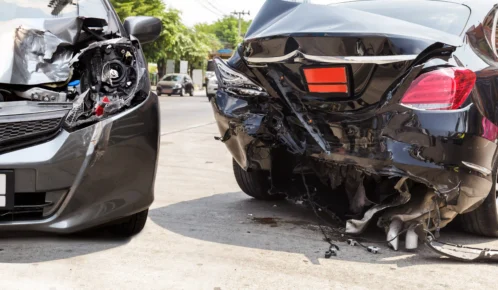You can file two separate claims for the same accident if two parties or entities are liable. Filing multiple injury claims enables you to maximize your compensation by holding each at-fault party financially responsible for your losses. For instance, if you were injured on the job and someone other than your employer caused the accident, you can file a workers’ compensation claim and a third-party personal injury claim simultaneously.
Table of Contents

At Ankin Law, our accident attorneys combine all aspects of Illinois injury law to make sure our clients recover maximum compensation. For a free consult, call 312-600-0000 now.
Can I Sue Multiple Parties for the Same Accident?
You have a right to sue multiple parties for the same accident if you suffered injuries or damages because of the negligence of two or more persons or entities. Joint and Several Liability is the legal doctrine that applies to this situation.
Joint liability means each party is legally responsible for all your recoverable damages. This rule comes in handy when the other party lacks insurance coverage or is incapable of paying.
Several liability implies that each party is only liable to pay for his or her percentage of the damages.
Pure Joint and Several Liability
Some states operate on a “pure joint and several liability” legal doctrine. This doctrine implies that you can only receive the exact amount of damages that the at-fault party is liable for, based on his or her percentage of fault.
Example: A court awards you $200,000 for your injury and determines that defendant A is 40% at fault and defendant B is 60%. In this case, you can only receive up to $80,000 from defendant A and up to $120,000 from defendant B. You cannot recover $200,000 from defendant A and zero from defendant B, and vice versa.
Modified Joint and Several Liability
Other states, like Illinois, operate on “modified joint and several liability” legal theory. This theory means a defendant whose share of fault for an accident is over 25% will be liable for a maximum of 100% of the damages awarded to the victim. This consideration applies when the other defendant lacks insurance, has insufficient insurance, or is incapable of paying.
Example: The court cleared you from any liability for your accident or injuries. It then awarded you $200,000 in economic damages and $200,000 in non-economic damages. If defendant A is 40% liable and carries $450,000 in insurance, and defendant B is 60% liable with no insurance, defendant A will be responsible for paying all your recoverable damages. Defendant A will pay economic damages worth $200,000 and non-economic damages worth $200,000 because B lacks insurance to cover the damages.
A defendant whose percent of fault for an accident is under 25% will be liable for 100% of the victim’s economic damages, but only severally responsible for the victim’s non-economic damages.
Example: You are not responsible for your accident, and the court awards you $200,000 in economic damages and $200,000 in non-economic damages. Defendant A is 85% liable and carries insurance coverage worth $25,000, and defendant B is 15% liable and has $450,000 in insurance. In this situation, defendant B will cover all your economic damages. Defendant B will, however, be responsible for only his or her percentage of the non-economic damages, which is 15% or $30,000.
Assigning fault in an accident involving multiple liable parties can be confusing and overwhelming, especially if you don’t have an attorney on your side. Ideally, you should hire a personal injury lawyer soon after the accident or hospital discharge to protect your right to recover full and fair compensation.
Can You Be Compensated Twice for the Same Injuries?
While you can file more than one claim for the same accident, you cannot be compensated twice for the same loss. Illinois law bars “double recovery,” which prevents an injury victim from receiving duplicate payments for identical damages.
In cases where both workers’ compensation and a third-party injury claim are involved, your employer’s insurance company may assert its right of subrogation. That means if you receive a third-party settlement, a portion may go toward reimbursing the workers’ comp provider for medical bills or wage loss benefits it paid.
An experienced personal injury attorney can structure your claims to maximize total compensation while minimizing how much is paid back through subrogation. Understanding the nuances of how each claim affects the other is critical to recovering the full value of your case.
When Can You File Two Separate Claims for the Same Accident?
You might be able to file two separate claims for the same accident when two parties are responsible for the resulting damages of the accident. Some instances when two parties could be liable for damages arising from the same accident include:
Multi-Car Accident
A multi-car accident is a crash that involves several vehicles. This type of accident typically happens due to the negligent actions of more than one driver. A chain reaction accident, which is a type of multi-car accident, is just one scenario where multiple parties may be liable for the same accident.
Example: Driver A is speeding behind Driver B, and traffic ahead stops suddenly. Driver A collides with the back of Driver B. Driver B, in turn, rear-ends Driver C because he or she was driving too closely to Driver C.
In the above scenario, Driver C can hold both Driver A and Driver B liable for the accident. Driver A will be at fault for speeding, while Drive B will be liable for violating the safe following distance rule.
Road Conditions
Local, state, and federal government agencies are responsible for keeping roads safe and well-maintained, but their negligence doesn’t always excuse reckless behaviors by other drivers. If a driver swerves to avoid a pothole or road hazard and hits you, you may be able to pursue a claim against the driver for swerving into you, and against a government agency for negligent road maintenance.
Slip and Fall Accident
Although these types of incidents usually involve premises liability claims, it’s common for slip and fall accidents to occur because of the negligence of multiple parties. For instance, if a contractor creates a hazard and a store owner fails to address or warn of it, both may share responsibility for a slip and fall injury. In that case, you may bring separate claims against each party.
Workplace Accidents
Third-party negligence at a job site can give rise to both a workers’ comp claim and a third-party injury claim. For example, if you’re injured by defective machinery supplied by an outside vendor, you could pursue compensation from your employer’s insurer through workers’ comp, and also sue the vendor.
Rideshare Accidents
If you’re injured while you are a passenger in a rideshare vehicle, the web of liability can get complicated. You may have claims against the driver’s insurance, the rideshare company’s insurer, the rideshare company itself, and another party who caused or contributed to the accident – such as a drunk or distracted driver.
Construction Site Injuries
Construction accidents often involve multiple contractors. If a subcontractor on a job site causes your injury, you may file for workers’ compensation with your employer and a third-party claim against the negligent contractor.
What Are the Benefits of Filing Multiple Claims for the Same Accident?
Filing multiple claims for the same accident can significantly increase your chances of recovering full compensation for your injuries and losses. In many cases, a single claim—whether through insurance, workers’ compensation, or a personal injury lawsuit—may not fully account for the financial and non-financial toll an accident has taken on your life. If more than one party contributed to your injury, pursuing all available claims can help ensure no avenue for recovery is left untapped.
Maximize Compensation for All Losses
The most important benefit of filing multiple claims is that it allows you to pursue all available compensation. For example, if you are injured at work due to a defective piece of machinery, you may file a workers’ compensation claim to cover your medical bills and lost wages. But workers’ comp benefits are limited. They typically don’t compensate you for pain and suffering or emotional distress. A third-party personal injury claim against the manufacturer of the defective equipment can help you recover damages that workers’ comp does not cover.
Similarly, in a multi-vehicle car accident, you may have a valid claim against more than one driver. Each driver’s insurance company may owe a portion of your total damages. By filing claims against all responsible parties, you increase your total recovery. If one party is underinsured or uninsured, the others may be forced to cover more of the total amount under doctrines like joint and several liability.
Protect Yourself Against Limited Insurance Coverage
Many injury victims run into issues when one liable party carries insufficient insurance. Filing multiple claims protects you from getting shortchanged. If one defendant is judgment-proof or uninsured, another may be held liable for the full amount of damages, especially in states like Illinois that follow modified joint and several liability rules. A skilled attorney can help you structure your claims to take full advantage of these legal protections.
Broaden Your Legal Strategy
Another benefit of filing multiple claims is strategic flexibility. Different claims follow different rules. For example, workers’ compensation is a no-fault system, while a personal injury lawsuit requires proof of negligence. By pursuing both routes, you hedge your bets. If one claim is denied or limited, the other may still succeed. Multiple claims can also give your attorney more leverage during settlement negotiations.
Strengthen Your Overall Case
Filing claims against multiple parties can help establish a stronger case by highlighting the full scope of liability. When more than one entity is held accountable, it reinforces the seriousness of your injuries and the widespread failures that contributed to your accident. This can improve your chances of a favorable outcome—whether at trial or in a settlement.
Don’t Leave Money on the Table
Ultimately, filing multiple claims is about financial survival. Accidents often come with steep costs: hospital bills, long-term rehab, lost income, emotional trauma, and lifestyle changes. Filing just one claim may not be enough to cover it all.
A personal injury attorney at Ankin Law in Chicago will evaluate your situation and determine which claims you’re entitled to file. Let us help you recover the compensation you truly deserve. Call 312-600-0000 now.



